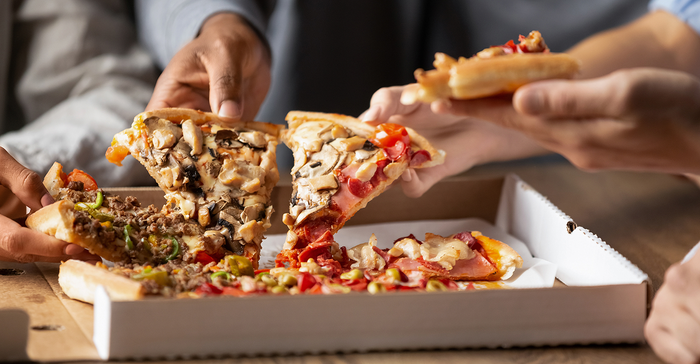Foodservice Packaging's Biggest Recycling Problems
Foodservice Packaging Institute reveals critical touchpoints impacting paper and plastic foodservice packaging recycling efforts.

Recycling paper cups, pizza boxes, and plastic takeout packaging might seem like a no-brainer but there’s significant room for improvement, both in recycling efforts and in the recycling stream, according to data released during a recent webinar hosted and presented by Foodservice Packaging Institute (FPI).
The informative presentation took a three-pronged approach, covering foodservice package recycling from three angles: thermoformed packaging, paper cups, and how the cleanliness of foodservice and residential recyclables effects recycling processes and effectiveness.
The presentation began with Katy Ricchi, consulting engineer, Resource Recycling Systems (RRS), overviewing a multi-partner project examining recycling pathways for PET thermoform packaging including cups, clamshells, trays, bowls, and deli, bakery, and take-out containers.
The summary of findings covered estimated material volumes in the marketplace and current recovery pathways. The study also posited relative costs and trade-offs for the potential pathways to increased recovery of this post–consumer material stream, whether through material recovery facilities (MRFs), PET reclaimers, or mixed plastics recyclers/plastics recycling facilities (PRFs).
Ricchi additionally referred to a study of topline challenges, which included flake analysis, pellet data and the overall impact on end market packaging applications. The study was conducted jointly by Plastics Forming Enterprises (PFE) and RRS.

Challenges and opportunities for paper cup recycling.
In his discussion on the state of paper cup recycling, Bill Moore, president, Moore & Associates, pointed to how MRFs are implementing optical sorting and robotics to improve their ability to sort paper cups, foodservice packaging, and other smaller volume types of paper packaging to help improve the bale output for the end market mill production of tissues and towel products, recycled paperboard, containerboard and recycled market pulp.
“Technology investment has been gradual to date, and primarily focused on optical sorting, due to low Mixed Paper prices at this time and the need to develop end markets that accept poly-coated paper packaging such as cups,” he commented. “With much improved prices for Mixed Paper (and Old Corrugated Containers) in 2021, growing investment in optical sorting as well as robotics is expected.”
MRFs are also working to broaden partnerships with local municipalities, providing public education to develop awareness about the benefits of adding paper cups to residential recycling programs. It used to be that MRFs were opposed to accepting cups and other foodservice materials due to concern about food contamination. However, Moore said recent observation has shown that by the time the cup makes it to the MRF, liquids are usually gone — a key factor in ensuring higher quality bale output for improving value and marketability.
A challenge of cup recycling is the presence of plastic lids, straws and stir sticks, but plastic components are also present on other types of paper packaging. MRFs have improved processes to remove more plastic from the paper stream, and mills are able to handle the small volume of such plastic items in recovered paper, he said.
Coated cups present another challenge. In the past, mills using cups and other poly-coated paper packaging have dealt with the time-consuming step of removing paper fiber from poly layers. Moore pointed to the promise of alternative cup materials and barrier coatings such as the biopolymer polylactic acid (PLA) and water-based aqueous coatings as exciting alternatives to traditional polyethylene coatings that will help smooth the process.
“As consumers and activist groups pressure large chain restaurants and consumer packaged goods brands to make packaging more recyclable, there is growing interest and activity in paper cup recycling,” he concluded. “Foodservice organizations, communities, and consumers alike have expectations that more types of single-use packaging should be recycled more often in future. The response from many restaurant brands and other foodservice operators has been to develop sustainability goals for the organization, in which packaging plays a major role.”

Gauging the impact of food residue on recyclables.
In the webinar’s final presentation, Holly Halliwill, consulting engineer, RRS, discussed the effect of food residue on recycling. One commonly cited reason that foodservice packaging is not accepted for recycling is its collective level of food contamination.
To address this concern, Halliwill pointed to a study conducted to learn whether foodservice packages like take-out containers, cups or pizza boxes were more contaminated than food contact packaging such as peanut butter jars, cans or pasta boxes that has traditionally been accepted at single-stream MRFs.
Thirteen 200-pound samples of randomly selected residential curbside recyclables were sorted, including corrugated packaging, paper and paperboard, molded fiber, plastic containers, and aluminum cans and trays/plates and placed into foodservice packaging or packaging in contact with food categories. The sort team used a visual rating system to assess individual packages in each of the selected categories to record the impact among foodservice versus food contact packaging, using a rating scale from 1 (clean) to 5 (highly contaminated).
The study found that the vast majority of foodservice and food contact packaging in the recycling stream are relatively clean and were rated as a 1 or 2. For paper and paperboard and plastic containers, both food contact and foodservice categories had similar, and extremely low rates of significant residue.
Packaging including peanut butter jars, plastic salad clamshells, ice cream cartons, and pizza boxes contained the most food residue. Across all materials and uses, the only categories that had more than 10% of packages with significant residue (ratings of 4 and 5) were Corrugated Foodservice Packaging with 17% and Molded Fiber Foodservice with 23%. All other categories had 7% or less of packages with significant residue (ratings of 4 and 5 together).
Molded fiber emerged as the category with the largest difference in food residue between food contact and foodservice packaging, with the foodservice subcategory significantly more frequently observed to contain food residue.
According to the study results, that was attributed to common foodservice molded fiber applications being prone to residue. Molded Fiber Foodservice packages rated a 1 or 2 were typically a drink cup holder, and those rated a 3 or 4 were typically a clamshell or a plate with food residue. The only Molded Fiber Food Contact packaging observed was egg cartons, which occasionally had minimal food residue but was typically clean, and overall had the lowest average rating of all sort categories.
Halliwill said that as part of the sorting process, samples were initially characterized in terms of total foodservice, total food contact, other recyclables, and trash, by weight. An average of 13% of the sampled material contained contaminants consisting of trash or other items that are not accepted by the MRF. This low contamination rate is an indicator of strong education programs, presumably making it less likely that residents would deposit highly contaminated packaging into their recycling carts.
Exepting molded fiber items, the percentage of foodservice and food contact items within the sorted material categories (OCC, plastic containers, aluminum, etc.) containing significant amounts of food residue is roughly the same. Halliwill concluded that additional studies will be needed at varying locations to develop a robust dataset, though all three studies conducted to date have provided similar conclusions.
About the Author(s)
You May Also Like




